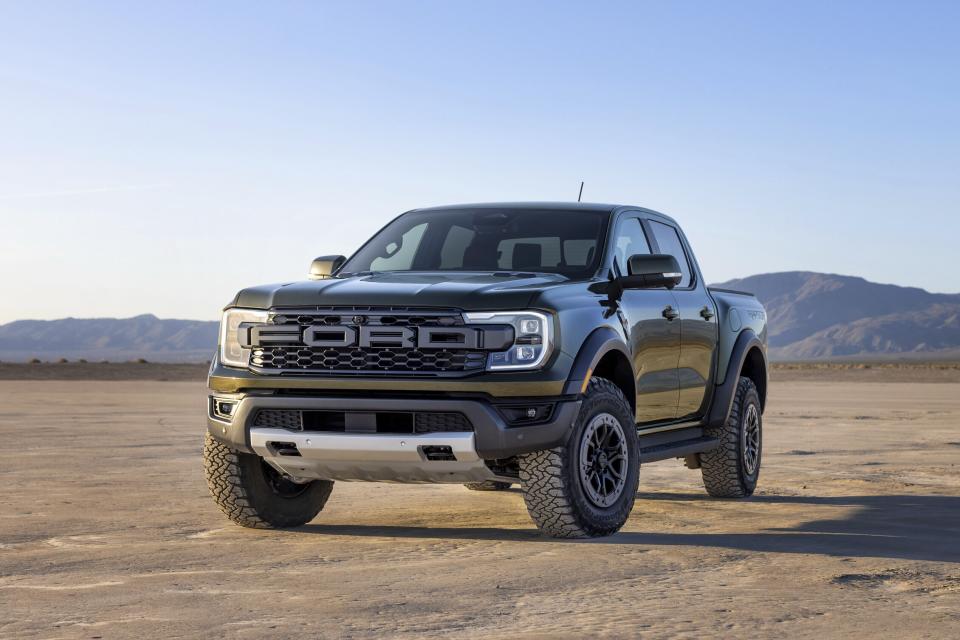Which midsize truck is better? Edmunds compares the Chevrolet Colorado and Ford Ranger
Buying a midsize truck can be a smart choice if you want a truck that’s capable but less expensive and more maneuverable than the typical full-size truck. There are quite a few options available and among them are two domestic headliners: the Chevrolet Colorado and Ford Ranger.
Both trucks have been recently rdesigned and dramatically improved. They’re also about as evenly matched as you can get, so much so that only one-tenth of a point separates them in Edmunds’ midsize truck rankings. You could be happy with either one yet they differ in small ways that could tip the balance based on your needs. Edmunds’ experts break down the attributes that will help you decide which is best for you.
POWER AND FUEL ECONOMY
The Ranger offers a trio of muscular engines, starting with a 270-horsepower turbocharged four-cylinder, followed by a larger 315-horsepower turbo V6. Even the base engine is surprisingly powerful for standard truck duties; for the true need-for-speed types, there is also off-road-focused Ranger Raptor trim that packs a 405-horsepower turbo V6.
Chevy doesn’t offer quite as extensive of a lineup. The Colorado has just a single turbocharged four-cylinder that produces 237 horsepower; an upgraded version is also available with 310 horsepower. Even the base engine makes plenty of low-end power that’s useful both for towing and keeping pace with city traffic. In Edmunds’ testing, the four-cylinder Ranger and the Colorado with its more powerful engine both accelerated from zero to 60 mph in a quick 6.7 seconds.
At its best, the four-cylinder Ranger gets an EPA-estimated 22 mpg combined in both rear- and four-wheel drive. The Colorado gets slightly lower estimates, with a base four-cylinder rated at 22 mpg combined for rear-wheel drive or 20 mpg combined for four-wheel drive. While the Colorado easily satisfies, the Ranger offers more variety, more power and better efficiency.
Winner: Ranger
TOWING AND PAYLOAD
Properly equipped, the Colorado’s can tow up to 7,700 pounds or haul up to 1,684 pounds. The Ranger tows slightly less — 7,500 pounds — but can haul more at 1,805 pounds. In real terms, both trucks are easily capable of pulling motorcycle trailers, small to midsize camper trailers, or many boats with ease.
There are a few minor differences that give the Ranger an advantage. Both trucks offer available tow packages that come with a trailer brake controller. This is a feature that allows you to adjust your trailer’s brakes from inside the cab. Also, the Ranger’s bed is slightly wider at 48 inches between the wheelwells, enough to fit a standard sheet of plywood. The Colorado’s bed is narrower by about 3 inches.
Winner: Ranger
OFF-ROAD CAPABILITY
Getting a stock truck that can perform in the dirt has never been easier. The Colorado’s Trail Boss trim starts you out with all-terrain tires and a raised suspension, while the ZR2 takes it further with more aggressive tires, upgraded shock absorbers, an even taller stance, and locking front and rear differentials. Chevy also offers a ZR2 Bison Edition that has even bigger tires and additional underbody protection.
For its part, Ford offers just one off-road version: the Ranger Raptor. But with its 405-horsepower engine, big all-terrain tires, and Fox racing-style shocks, the Raptor is a premier dirt and desert runner. The Raptor isn’t built so much for climbing tricky terrain — although it can do that, too — as it is crossing dirt, mud, dust and washboard roads at speed.
Winner: tie
TECHNOLOGY AND VALUE
Inside the cab, the Colorado’s 11.3-inch touchscreen offers more real estate than the Ranger’s 10-inch display, and it’s underpinned by faster Android-based software that includes Google voice assistant. The Ranger offers a larger 12-inch vertical display but it only comes standard on the well-equipped Lariat and Raptor trims. The Ranger also buries some basic functions, such as climate controls, within the touchscreen rather than having them be easier-to-use physical buttons.
The Colorado is also less expensive, at least initially. Pricing starts at $31,095 for a rear-wheel-drive Colorado WT, including destination. For the least expensive Ranger XL, you’re looking at $34,315. There’s a big price difference between the top Colorado ZR2 and Ford Ranger Raptor too. But dig deeper and you’ll notice that Ford generally equips the Ranger’s trim levels with more standard features to justify the price; adding those features through various option packages on the Colorado closes the gap considerably. Ultimately, though, we like that Chevy gives shoppers a lower entry point and more ways to get a truck exactly how they want.
Winner: Colorado
EDMUNDS SAYS
The Ranger tops a majority of the categories in this round-up and stands as Edmunds’ top-rated midsize truck. But this contest is so close that we can easily understand why you’d want to get a Colorado instead.
____________
This story was provided to The Associated Press by the automotive website Edmunds.
Dan Frio is a contributor at Edmunds.

 Yahoo Finance
Yahoo Finance 

